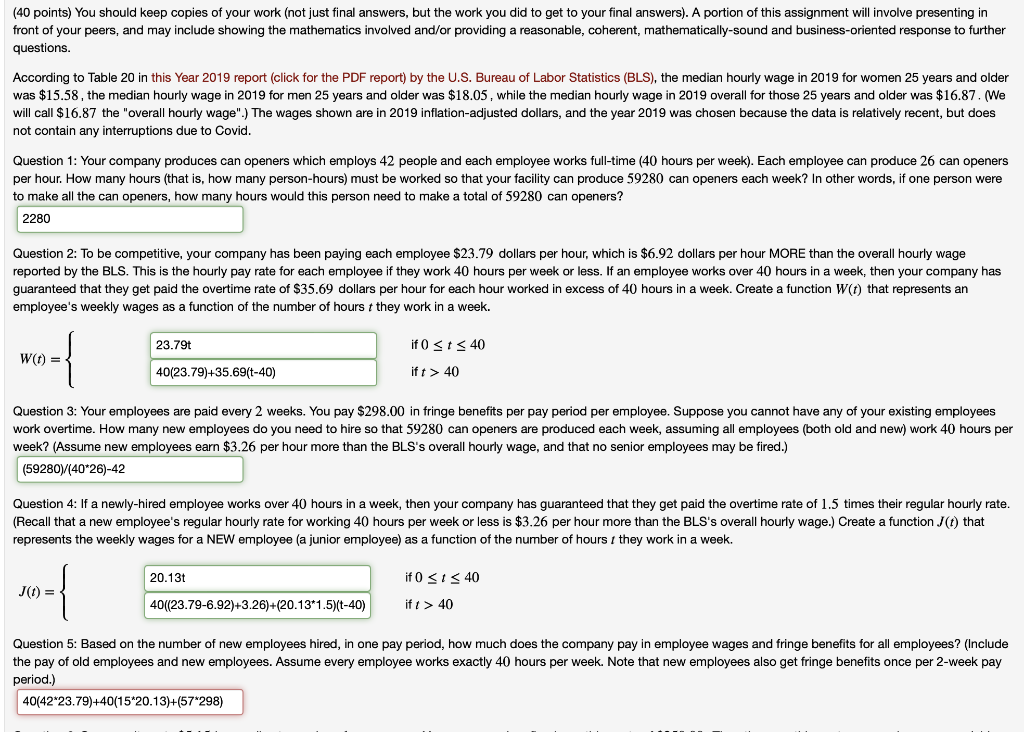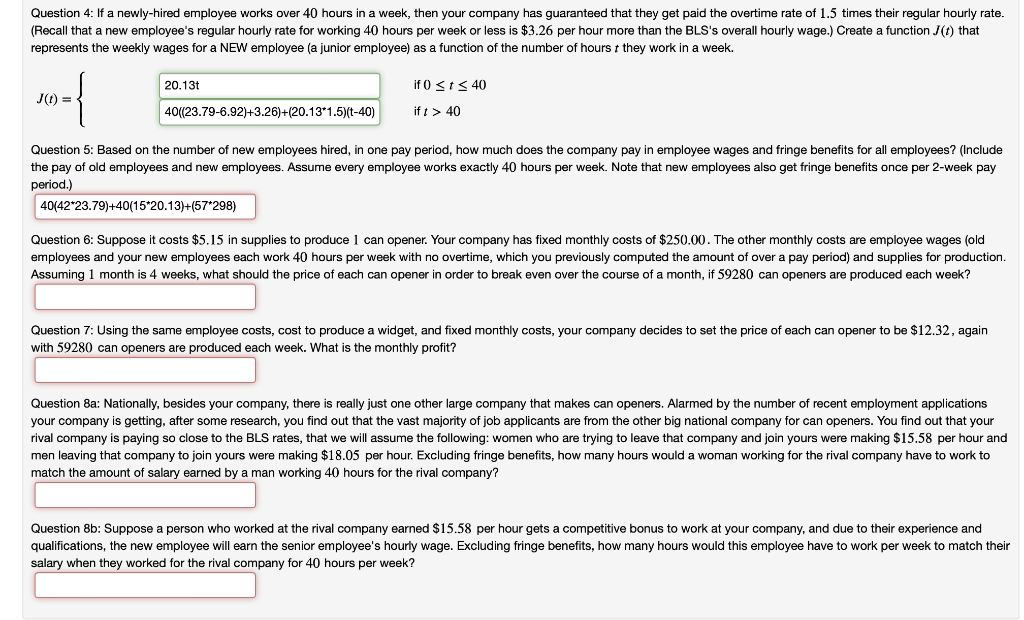

(40 points) You should keep copies of your work (not just final answers, but the work you did to get to your final answers). A portion of this assignment will involve presenting in front of your peers, and may include showing the mathematics involved and/or providing a reasonable, coherent, mathematically-sound and business-oriented response to further questions. According to Table 20 in this Year 2019 report (click for the PDF report) by the U.S. Bureau of Labor Statistics (BLS), the median hourly wage in 2019 for women 25 years and older was $15.58, the median hourly wage in 2019 for men 25 years and older was $18.05, while the median hourly wage in 2019 overall for those 25 years and older was $16.87. (We will call $16.87 the "overall hourly wage".) The wages shown are in 2019 inflation-adjusted dollars, and the year 2019 was chosen because the data is relatively recent, but does not contain any interruptions due to Covid. Question 1: Your company produces can openers which employs 42 people and each employee works full-time (40 hours per week). Each employee can produce 26 can openers per hour. How many hours (that is, how many person-hours) must be worked so that your facility can produce 59280 can openers each week? In other words, if one person were to make all the can openers, how many hours would this person need to make a total of 59280 can openers? Question 2: To be competitive, your company has been paying each employee $23.79 dollars per hour, which is $6.92 dollars per hour MORE than the overall hourly wage reported by the BLS. This is the hourly pay rate for each employee if they work 40 hours per week or less. If an employee works over 40 hours in a week, then your company has guaranteed that they get paid the overtime rate of $35.69 dollars per hour for each hour worked in excess of 40 hours in a week. Create a function W(t) that represents an employee's weekly wages as a function of the number of hours t they work in a week. W(t)={if0t40ift>40 Question 3: Your employees are paid every 2 weeks. You pay $298.00 in fringe benefits per pay period per employee. Suppose you cannot have any of your existing employees work overtime. How many new employees do you need to hire so that 59280 can openers are produced each week, assuming all employees (both old and new) work 40 hours per week? (Assume new employees earn $3.26 per hour more than the BLS's overall hourly wage, and that no senior employees may be fired.) Question 4: If a newly-hired employee works over 40 hours in a week, then your company has guaranteed that they get paid the overtime rate of 1.5 times their regular hourly rate. (Recall that a new employee's regular hourly rate for working 40 hours per week or less is $3.26 per hour more than the BLS's overall hourly wage.) Create a function J(t) that represents the weekly wages for a NEW employee (a junior employee) as a function of the number of hours t they work in a week. J(t)={if0t40ift>40 Question 5: Based on the number of new employees hired, in one pay period, how much does the company pay in employee wages and fringe benefits for all employees? (Include the pay of old employees and new employees. Assume every employee works exactly 40 hours per week. Note that new employees also get fringe benefits once per 2-week pay period.) Question 4: If a newly-hired employee works over 40 hours in a week, then your company has guaranteed that they get paid the overtime rate of 1.5 times their regular hourly rate. (Recall that a new employee's regular hourly rate for working 40 hours per week or less is $3.26 per hour more than the BLS's overall hourly wage.) Create a function J(t) that represents the weekly wages for a NEW employee (a junior employee) as a function of the number of hours t they work in a week. J(t)={if0t40ift>40 Question 5: Based on the number of new employees hired, in one pay period, how much does the company pay in employee wages and fringe benefits for all employees? (Include the pay of old employees and new employees. Assume every employee works exactly 40 hours per week. Note that new employees also get fringe benefits once per 2-week pay period.) Question 6: Suppose it costs $5.15 in supplies to produce 1 can opener. Your company has fixed monthly costs of $250.00. The other monthly costs are employee wages (old employees and your new employees each work 40 hours per week with no overtime, which you previously computed the amount of over a pay period) and supplies for production. Assuming 1 month is 4 weeks, what should the price of each can opener in order to break even over the course of a month, if 59280 can openers are produced each week? Question 7: Using the same employee costs, cost to produce a widget, and fixed monthly costs, your company decides to set the price of each can opener to be $12.32, again with 59280 can openers are produced each week. What is the monthly profit? Question 8a: Nationally, besides your company, there is really just one other large company that makes can openers. Alarmed by the number of recent employment applications your company is getting, after some research, you find out that the vast majority of job applicants are from the other big national company for can openers. You find out that your rival company is paying so close to the BLS rates, that we will assume the following: women who are trying to leave that company and join yours were making $15.58 per hour and men leaving that company to join yours were making $18.05 per hour. Excluding fringe benefits, how many hours would a woman working for the rival company have to work to match the amount of salary earned by a man working 40 hours for the rival company? Question 8b: Suppose a person who worked at the rival company earned $15.58 per hour gets a competitive bonus to work at your company, and due to their experience and qualifications, the new employee will earn the senior employee's hourly wage. Excluding fringe benefits, how many hours would this employee have to work per week to match their salary when they worked for the rival company for 40 hours per week








